Both Glengoyne 12-year and 10-year appear to be on the US market at the same time, which is a little odd. Usually distilleries stick to one of the classic “flagship” ages. The 12 retails for $10-$15 more than the 10, and my review of the 12 year shows that I appreciated that one as budget sherry bomb. This 10 year-old (which is the only one of the two I can find near me) is the same bottling strength (43%), also has no added coloring, and also uses both ex-bourbon and sherry casks (like The Balvenie DoubleWood and about a zillion other malts these days). Both are apparently not chill-filtered (see comments). As far as I can tell, the 2 years of maturation and the $10-$15 of price are the only differences.
Glengoyne, technically classed as a Highland whisky, toes the Highland line some 20 miles north of Glasgow. In fact, its warehouses sit on the south side of the road, in the Lowlands! There likely aren’t many whiskies that can claim to be distilled in the Highlands and aged in the Lowlands. Glengoyne is a small facility with limited production, which may contribute to its consistently high-quality malt.
The distillery’s marketing – including right on the bottle labels – is very adamant that the whisky has absolutely no peat character at all, either from the process water or from the barley, which is unusual at zero ppm (even traditionally unpeated Highlanders like Glenlivet have around 2 ppm). The distillery has a right to market its insistence on showcasing the barley, as it is one of two remaining producers that use Golden Promise barley. The other is The Macallan. Golden Promise is considered to be of higher quality, but much more expensive to grow than high-yield commercial strains. Glengoyne uses a mix of first-fill sherry, refill sherry, and ex-bourbon casks, although its whisky is immediately recognizable as a sherried Highland-style whisky.
Nose: Sherry! Fresh fruit, green apple and fresh snappy pear in spades. Kefir lime leaves and faintly sweet malt. The sherry is dominant here. Mild nose tickle.
Palate: Thin body. Mild to moderate tongue burn. Tropical fruits (kiwi, fresh coconut), mildly herbal (anise, cardamom), and just a little bit of bitterness. Not as tart as the aroma implied.
Finish: Medium-short. Some slightly-bitter barrel char. Vague, without much of the fruit but with some of the herbs. Fades without evolving.
With Water: The addition of a few drops of water muddy the tropical fruits and add only a little sweetness in the form of bland white sugar. The palate is thinner, but the finish has some sparkle and a little of the missing tartness. I’d probably skip the water at 43% ABV, but you could see if it does anything for you.
Overall: The aroma promises more than the palate can deliver, but it’s still a pleasant dram with nice fruit flavors. The sherry notes, which dominate, are definitely of the “fresh tropical fruit” variety, and not of the “dried and jammy fruit” variety. There are no off-notes, and the whisky’s balance is well-struck. I snagged my bottle on closeout for $27, making it a steal, but I’d be just about as happy with this at $40. Much above that and the value falls away. If you have access to both the 10 and the 12, I think that the 12 is better and worth an extra $10-$15, but I wouldn’t pay more than $50 for it.

About The Distillery
Owned by Ian Macleod Distillers, Glengoyne will go out of its way to tell you that it’s not peated, in any form. Despite being located only 20 miles from categorical Lowlander Auchentoshan, Glengoyne distillery actually lies on the north side of the Highland Line, although its warehouses lie on the Lowland side. Slow fermentation (56 hours) and slow distilling with maximum copper contact are responsible for the nutty character of Glengoyne’s malt, as is its careful use of both first-fill sherry casks and ex-bourbon casks. Glengoyne is also proud of its continued use of Golden Promise barley, which is of higher quality but harder to grow than other commercial strains. It shares this trait with The Macallan. Process water comes from the Glengoyne burn which flows from Loch Lomond, in the Highlands.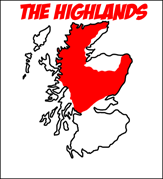


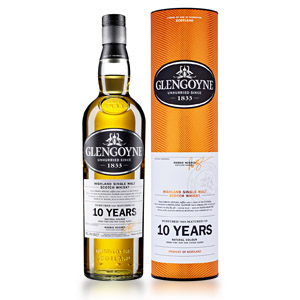
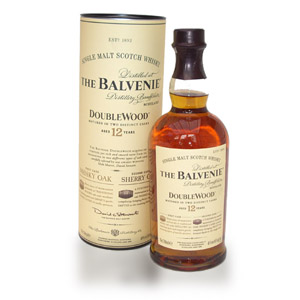

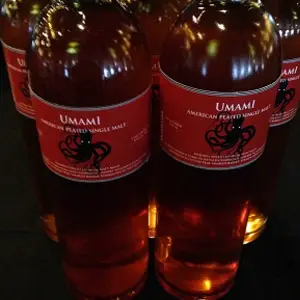
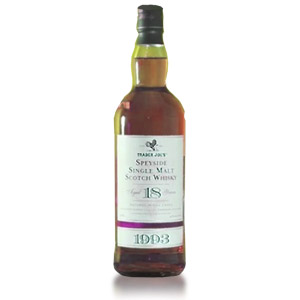

The Total Wine where I shop actually carries both of these side by side. Since the 12 is only $8 more I’ve never bothered to try this. While the 12 is not a favorite of mine, it is something that I revisit from time to time, especially in the warmer months. I agree that you get a lot of fresh tropical fruit with it, as opposed to the funky, dried fruit that is normal for sherry maturation.
Glengoyne 10 is partially filtered, but NOT chill-filtered. I just watched an online review where the reviewer made abundantly clear that it is NOT chill-filtered.
Thanks for the note – post updated.